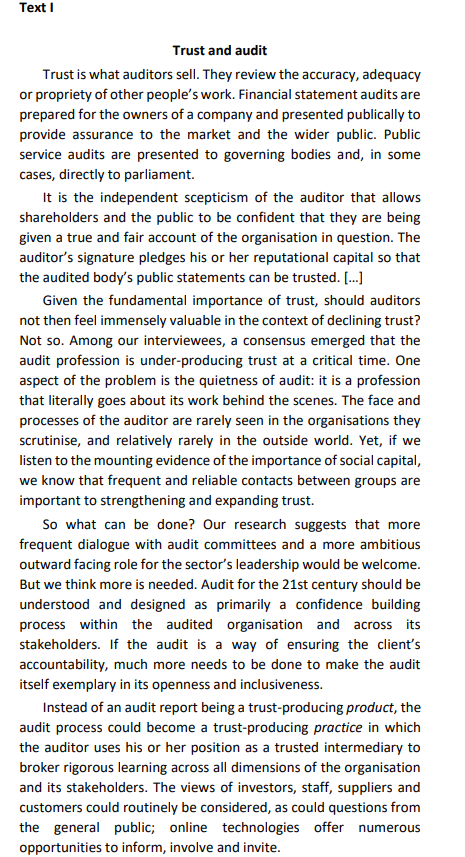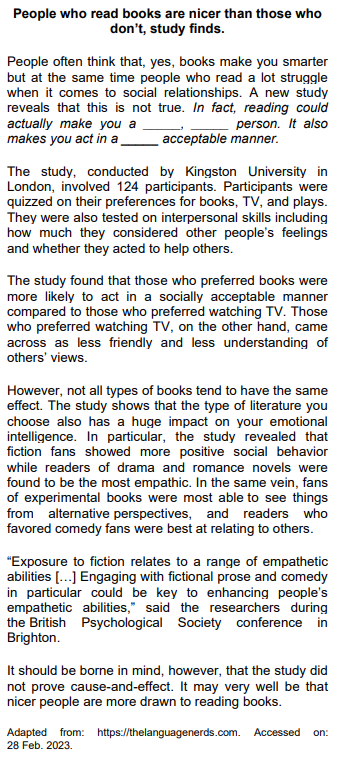In the section of paragraph 4 “the third party would then scrutinize the data on behalf of the website to guess a user’s personality, their preferences, and what they are likely to do next”, the expression what they are likely to do next refers to the children’s
In the fragment of paragraph 7 “Lawmakers should amend the law to establish comprehensive child data protection rules”, the word should indicates a(n)
Digital technology is everywhere, and it is changing the way citizens behave. From working patterns to the day-to-day services we use and the places we live, there is no aspect of modern life that remains untouched by digital tools and solutions. This represents both the biggest challenge and opportunity for public sector organizations as they seek to engage citizens and create future-proofed, sustainably-minded societies.
The public sector plays a key role in setting the sustainability agenda for society, including the approach to circularity and recycling. While private sector companies can greatly influence the successful achievement of sustainability targets, the public sector bears the responsibility for outlining how society can achieve these goals more broadly at both national and local levels. By embracing the same digital technologies that are transforming their citizens’ lives, public sector organizations can help pivot society towards a more sustainable tomorrow.
In addition, there has been a rise of smart cities and the circular economy. Urban areas account for 75% of global carbon dioxide emissions, and the 100 cities with the greatest footprints account for 18% of global emissions. But there are more than 70 cities worldwide pledging to become carbon neutral by 2050.
Public sector actors can fuel sustainable transformation by releasing capital to invest in sustainable city transformation projects and smart cities. By tapping into the value of data and green infrastructure, smart cities can combat climate risks and become more resilient to the many unexpected events of today’s increasingly unpredictable world. These cities can supportthe decoupling of resource use and environmental impacts by diffusing circular economy approaches to production and consumption.
Internet: (adapted).
Based on the ideas presented in the previous text, as well as on its linguistic aspects, judge the following items.
Smart cities are sure to tackle climate risks and become more resistant to the many unpredictable events of the planet by tapping into the value of data and green infrastructure.
Does Snoozing Your Alarm Really Increase Sleepiness?
Snoozing the alarm doesn’t necessarily mean you’ll feel groggy the rest of the day. But it’s important to get as much sleep as you can. Getting up early in the morning is no easy task for plenty of people. That’s why alarms are important — they ensure that you wake up at your desired time. However, nobody can deny how tempting it is to try and squeeze in a few more minutes of sleep.
According to a survey, about 57 percent of people snooze in the morning, which is defined as needing multiple alarms to wake up. If you set a single alarm and snooze it repeatedly or set several alarms at regular intervals until the time you absolutely need to get up, you are a snoozer. Waking up on the first alarm is commonly recommended, but does it really make a difference if you are woken up by one alarm compared to several ones? In a recent sleep study, researchers examine how snoozing affects an individual’s health and sleep.
According to the study, people snooze for a variety of reasons. Most of the participants said that they just can’t get up with only the first alarm. Some say they snooze because they feel comfortable in bed, while others do it because they feel less tired when they do get up. A researcher said that snoozing might be a sign that people are waking up because of important scheduled activities — like school or work — rather than because they have adequately rested.
Internet: <www.discovermagazine.com> (adapted)
According to the preceding text, judge the following items.
The adverb “However” (last sentence of the first paragraph), can be correctly replaced by Therefore, without changing the meaning of the text.
Using your phone while on the toilet poses significant health risks, as warned by an expert, Dr. Sethi. Despite being a common habit, mindlessly scrolling or using your phone in the bathroom can lead to severe consequences. Dr. Sethi, a Harvard-trained stomach doctor, highlights that this practice, particularly during bowel movements, causes extended sitting that strains the rectum and anus, potentially resulting in hemorrhoids, anal fissures, and rectal prolapse.
Furthermore, using phones in the bathroom makes them a breeding ground for bacteria, surpassing the hygiene levels of a public toilet seat. Dr. Sethi emphasizes the importance of avoiding phone usage while on the toilet or, if unavoidable, suggests disinfecting the phone afterward. Research spanning over a decade has consistently shown that phones harbor a significant amount of germs, including fecal matter.
Despite these health warnings, over 65% of adults take their phones into the bathroom, with Spain having the highest usage rates (nearly 80%) and Germany the lowest (just under 55%). Interestingly, younger age groups, particularly those aged 26-41 and 18-25, are most likely to engage in this unhygienic behavior. Apart from health concerns, there’s the practical risk of dropping the phone into the toilet, with a fifth of respondents in the United States admitting to this mishap.
Internet: <www.mirror.co.uk> (adapted).
Based on the previous text, judge the following items.
Although it is a usual habit to scroll one’s phone while in the bathroom, it poses minor risks to someone’s health.
Text I
Shock of the old: Believe it or not, battery-powered vehicles
have been around since Victorian times.
The history of the electric car is surprisingly enraging. If you
imagine early electric vehicles at all (full disclosure: I didn’t until
recently), it will probably be as the quixotic and possibly dangerous
dream of a few eccentrics, maybe in the 1920s or 1930s, when
domestic electrification became widespread. It’s easy to imagine
some stiff-collared proto-Musk getting bored of hunting and
affairs, eyeing his newly installed electric lights speculatively, then
wreaking untold havoc and mass electrocutions. The reality is
entirely different.
By 1900, a third of all cars on the road in the US were electric;
we’re looking at the history of a cruelly missed opportunity, and it
started astonishingly early. The Scottish engineer Robert Anderson
had a go at an electric car of sorts way back in the 1830s, though
his invention was somewhat stymied by the fact rechargeable
batteries were not invented until 1859, making his crude carriage
something of a one-trick pony (and far less useful than an actual
pony).
It’s debatable whether or not Scotland was ready for this brave
new world anyway: in 1842, Robert Davidson (another Scot, who
had, a few years earlier, also tried his hand at an electric vehicle)
saw his electric locomotive Galvani “broken by some malicious
hands almost beyond repair” in Perth. The contemporary
consensus was that it was attacked by railway workers fearful for
their jobs.
Despite this unpromising start, electric vehicles had entered
widespread commercial circulation by the start of the 20th
century, particularly in the US. Electric cabs crisscrossed
Manhattan, 1897’s bestselling US car was electric and, when he
was shot in 1901, President McKinley was taken to hospital in an
electric ambulance. London had Walter Bersey’s electric taxis, and
Berlin’s fire engines went electric in 1908; the future looked bright,
clean and silent.
By the 1930s, however, the tide had definitively turned against
electric, cursed by range limitations and impractical charging times
while petrol gained the upper hand thanks partly – and ironically –
to the electric starter motor. The Horseless Age magazine, which
vehemently backed the petrol non-horse, would have been
delighted. There was a brief resurgence of interest in the late
1960s, when the US Congress passed a bill promoting electrical
vehicle development, but nothing much actually happened until
the Nissan Leaf sparked interest in 2009. Electric still isn’t quite
there yet, battling infrastructure and battery problems that might
have been familiar to Anderson and friends.
Adapted from The Guardian, Tuesday 24 October 2023, p. 6
https://www.theguardian.com/lifeandstyle/series/shock-of-the-old/2023/oct/24/all
Based on the text, mark the statements below as TRUE (T) or FALSE (F).
( ) The history of electric cars has been fraught with flawed
assumptions.
( ) Robert Anderson’s invention in the 1830s was triggered off by
the launching of rechargeable batteries.
( ) The 19th century Scottish locomotive engineer is said to have
quashed social resistance.
The statements are, respectively,
Text I
Shock of the old: Believe it or not, battery-powered vehicles
have been around since Victorian times.
The history of the electric car is surprisingly enraging. If you
imagine early electric vehicles at all (full disclosure: I didn’t until
recently), it will probably be as the quixotic and possibly dangerous
dream of a few eccentrics, maybe in the 1920s or 1930s, when
domestic electrification became widespread. It’s easy to imagine
some stiff-collared proto-Musk getting bored of hunting and
affairs, eyeing his newly installed electric lights speculatively, then
wreaking untold havoc and mass electrocutions. The reality is
entirely different.
By 1900, a third of all cars on the road in the US were electric;
we’re looking at the history of a cruelly missed opportunity, and it
started astonishingly early. The Scottish engineer Robert Anderson
had a go at an electric car of sorts way back in the 1830s, though
his invention was somewhat stymied by the fact rechargeable
batteries were not invented until 1859, making his crude carriage
something of a one-trick pony (and far less useful than an actual
pony).
It’s debatable whether or not Scotland was ready for this brave
new world anyway: in 1842, Robert Davidson (another Scot, who
had, a few years earlier, also tried his hand at an electric vehicle)
saw his electric locomotive Galvani “broken by some malicious
hands almost beyond repair” in Perth. The contemporary
consensus was that it was attacked by railway workers fearful for
their jobs.
Despite this unpromising start, electric vehicles had entered
widespread commercial circulation by the start of the 20th
century, particularly in the US. Electric cabs crisscrossed
Manhattan, 1897’s bestselling US car was electric and, when he
was shot in 1901, President McKinley was taken to hospital in an
electric ambulance. London had Walter Bersey’s electric taxis, and
Berlin’s fire engines went electric in 1908; the future looked bright,
clean and silent.
By the 1930s, however, the tide had definitively turned against
electric, cursed by range limitations and impractical charging times
while petrol gained the upper hand thanks partly – and ironically –
to the electric starter motor. The Horseless Age magazine, which
vehemently backed the petrol non-horse, would have been
delighted. There was a brief resurgence of interest in the late
1960s, when the US Congress passed a bill promoting electrical
vehicle development, but nothing much actually happened until
the Nissan Leaf sparked interest in 2009. Electric still isn’t quite
there yet, battling infrastructure and battery problems that might
have been familiar to Anderson and friends.
Adapted from The Guardian, Tuesday 24 October 2023, p. 6
https://www.theguardian.com/lifeandstyle/series/shock-of-the-old/2023/oct/24/all
In “Despite this unpromising start” (4th paragraph), the first word can be replaced by:
Based on Text I, mark the statements below as TRUE (T) or FALSE (F).
I. In auditing, taking heed of what other parties have to say needs to be downplayed.
II. Auditors are generally unobtrusive when carrying out their jobs.
III. Trust is obtained when auditors eschew straightforward statements.
The statements are, respectively,
Em 24 de outubro de 2019, o site https://www.amnesty.org/en/ latest/news/2019/10/gunviolence-report/ publicou depoimentos demulheres reais, do estado de Louisiana, nos Estados Unidos, que sofreram violência doméstica.
Do depoimento transcrito a seguir, foram extraídas frases as quais estão apresentadas isoladamente na sequência.
Preencha as lacunas do texto com as frases destacadas e, a seguir, assinale a alternativa que contém a sequência CORRETA na ordem de cima para baixo:
“Angela's story:
In my case, it started as verbal abuse. I’d known my partner for 20 years and he was a good person. _______________________. After his mum died, he bought several guns including a machete and a shotgun. He became more combative, not only with me but with others and through his social media. I couldn’t do anything right. One evening in early November it turned physical. We were having a conversation and at some point it escalated and I asked him to leave. I walked over to the door, opened it and said we could have the conversation another day. _____________________________. I managed to yell for our oldest son and he got off of me and left. We’d broken up, but we were starting to work things out again, when one morning we had a disagreement________________________. I can only remember the last two gunshots._____________________________. He returned with my cell phone and I told him to dial 911. I felt as though I was dying. My legs felt prickly. I didn’t realize he’d shot me in the back and I was already paralyzed. (...)
Fonte: https://www.amnesty.org/en/latest/news/2019/10/gun-violence-report/
I. He grabbed me by the hood of my sweatshirt, threw me out my door and got on top of me and started choking me.
II. I was in the bathtub, when he came in and shot me.
III. He started changing in 2015.
IV. I look up at him and he says ‘Look what you made me do Angie’, ‘You made me shoot you.
Do statements agree with the information from the Text 2? Decide True (T) if the statement agrees with the information from the article or False (F) if the statement contradicts the information from the article.
( ) The study has shown that although people who read tend to be more intelligent, they have more difficulties with social interactions.
( ) The study with 124 participants researched their own reading preferences as well as how they notice what is happening to other people.
( ) People who prefer watching TV tend to be more polite and better behaved.
( ) Literature as a whole affects people equally, regardless of the genre.
( ) The study does not decisively prove that reading actually makes people become nicer.
Now choose the alternative with the correct sequence
In the segment of 5th paragraph “the worst outcome would be to let inflation take root”, the words would be signal
Considering the context presented in the text, the sentence “The sinking took place nowhere near an enemy” (l. 05-06) suggests that the ship’s location in relation to an enemy was:
Consider the following statements about the word “can” in the sentence “Video can explain steps more naturally” (l. 13) in the context presented in the article:
I. Its past form is “could”.
II. It could be replaced by “must” with no significative changes in meaning.
III. It expresses permission.
Which statements are correct?










